Tamil cuisine
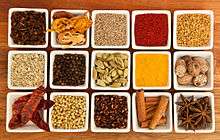 |
| This article is part of the series |
| Indian cuisine |
|---|
|
Regional cuisines
|
|
Ingredients, types of food |
|
See also
|
|
| Part of a series on |
| Tamils |
|---|
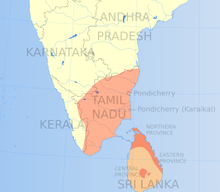 |
Tamil cuisine is a cuisine native to the Tamil people who are native to the Indian state of Tamil Nadu and northern Sri Lanka. It is also the cuisine of the Tamil-speaking population of Karnataka, Kerala and Andhra Pradesh in India and of the Tamil communities of Singapore and Malaysia.
Tamil Nadu is famous for its deep belief that serving food to others is a service to humanity[1], as it is common in many regions of India. The region has a rich cuisine involving both traditional vegetarian and non-vegetarian dishes. Rice, legumes and lentils are used extensively and flavor is achieved by the blending of various spices. Vegetables and dairy products are essential accompaniments and tamarind is used as the favored souring agent.
On special occasions, traditional Tamil dishes are prepared in an elaborate and leisurely way and served in traditional style on a banana leaf. The traditional way of eating a meal involves being seated on the floor, having the food served on a banana leaf, and using clean fingers of the right hand to transfer the food to the mouth. After the meal, the fingers are washed, and the banana leaf becomes food for cows. Typically breakfast includes idli or dosa and rice accompanied by sambar and rasam, followed by curd for lunch.
Typical meals
sappadu (a typical meal) consists of rice with other typical Tamil dishes served on a banana leaf which gives different flavor and taste to the food,then a dessert (normally Paayasam) is usually served as a dessert to finish the meal. Coffee and tea are the staple drinks.[2]
‘Virundhu’ which means‘feast’, when guests are invited during happy ceremonial occasions to share food. For festivals and special ceremonies, a more elaborate menu with steamed rice, variety rice (e.g. tomato rice), dal, sambar (lentil stew), kara kuzhambu (spicy stew with a coconut base or dal base), rasam (tamarind stew with other herbs and spices), thayir (curd) along with poriyal (dry fry of vegetables), varuval (oil fry of the vegetables or meat), kootu (vegetables mixture with green dal or coconut), keerai masiyal (ground greens), aviyal (a mixture of cooked vegetables, finally added with buttermilk or curd in the preparation), pachadi (salad of cucumber, or onion in curd), appalam (fried papads), thovaiyal (wet ground paste of some item), oorukai (pickles), payasam (sweet liquid of many varieties with milk base or coconut milk base or dal liquid base). After the completion of the feast, a banana and betel leaves (eaten with areca nuts and limestone paste) are provided to aid digestion.
Guests sit on a coir mat rolled out on the floor and a full course meal was served on a banana leaf. Nowadays, guests often sit at a dinner table and have the same type of food. Traditionally the banana leaf is laid so that the leaf tip is pointed left. Before the feast begins the leaf is sprinkled with water and cleaned by the diner himself even though the leaves are already clean. The top half of the banana leaf is reserved for accessories, the lower half for the rice. The lower right portion of the leaf may have a scoop of warm sweet milky rice Payasam, Kesari, Sweet Pongal or any Dessert items. While the top left includes a pinch of salt, a dash of pickle and a thimbleful of salad, or a smidgen of chutney. In the middle of the leaf there may be an odd number of fried items like small circles of chips either banana, yam or potato, thin crisp papads or frilly wafers aruna Appalams and vadai. The top right hand corner is reserved for spicy foods including curry, hot, sweet, or sour and the dry items.
Dishes
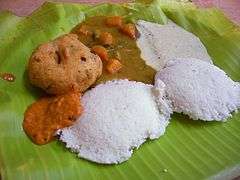

.jpg)
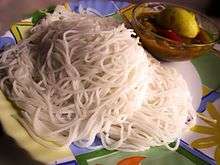
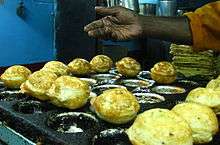
Rice is the major staple food of most of the Tamil people. Normally lunch or dinner is a meal of steamed rice (choru) served with accompanying items, which typically include sambar, poriyal (curry), rasam, kootu and curd.
Breakfast dishes
Main dishes
- Idli, steamed rice-cakes, prepared from a fermented batter of rice and black gram. Usually served alongside different kinds of chutney, sambhar or vadacurry.
- Dosai, crepes made from a fermented batter of rice and black gram eaten with Sambar or chutney. Several varieties like saada dosai, kal dosai, muttai dosai, neer dosai, rava dosai, paasi paruppu dosai, etc. are available.
- Vadai, commonly of 2 types, based on the ingredients used and served along with idlis.
- Pongal, a traditional cuisine where rice is cooked in a mud pot along with water and milk until the boiling liquid forms viscous frothy bubbles that rise above the pot. The soft, creamy upper layer overflows the pot, which is also called a pongal.
- Paniyaram, the batter similar to the one used to make dosa is poured into pan with small pits to make paniyaram.
- Appam, is made from a fermented batter of rice and black gram mixture, which is made into a thin consistency. It is poured over a hot pan and spread evenly by rotating the pan. The appam generally has its sides thin and the centre is fluffy and soft.
- Uthappam, a dosa variety, which is slightly thick, fluffy, and soft. It can be made from regular idli / dosai batter. Plain uthappam is available, along with a type of uthappam with vegetables or onions sprinkled over.
- Upma, made from wheat or rava, added with onion, green chillies. May also be substituted with broken rice granules, flattenned rice flakes, or almost any other cereal grain instead of broken wheat.
- Puttu - Steamed layered, cylindrical cakes made with flour; usually rice flour is used but any miller flour can be used. The flour is sparsely mixed with water and packed into puttu cylinder and steamed. The flour is usually layered with grated coconut.
- Kozhukkattai - Steamed dumplings made with rice flour. The fillings are varied: from grated coconut and jaggery to various savoury preparations.
- Sevai or Idiyappam, rice noodles made out of steamed rice cakes
- Adai, with all the vegetables, it is a complete and quite filling meal. It is loaded with fiber and calcium. Its a perfect recipe for people on diet and for diabetic patients.
Side dishes
- Sambar, is a lentil-based vegetable stew or chowder cooked with a tamarind broth and freshly grounded spices.
- Vada Curry, a classic chettinad side dish which is also very famous in Chennai.
- Thogaiyal, which is a wet ground paste of many ingredients but primarily with the punch of the main ingredient. Most common thogaiyals by their chief ingredient are like coconut, paruppu (dal), coriander, puthina (mint leaves), karuveppilai (curry leaves), ellu (seasame seeds), kollu (horse gram), inji (ginger), poondu (garlic) etc.
- Kootu - a stew of vegetables or greens, usually made with lentils, and spices which makes for a side dish for a meal consisting of rice, sambhar and rasam.
- Aviyal - a stew of vegetables with fresh coconut, and coconut oil which makes for a side dish for a meal consisting of rice, sambhar, rasam and equally for dishes like Adai and Thosai. In hotels it is an evening specialty food and advertised as Adai Aviayal.
Drinks
- Coffee is the most popular beverage. Coffee is a major social institution in Southern Indian Tamil tradition and generally use gourmet coffee beans of the premium Peaberry or the less expensive Arabica variety. The making of filter coffee is like a ritual, as the coffee beans are first roasted and then powdered. Sometimes chicory is added to enhance the aroma. A filter set is used and few scoops of powdered coffee with boiling water is used to prepare a dark liquid called the decoction. Hot milk with sugar and a small quantity of decoction is then served in a tumbler set, a unique coffee cup. Another popular beverage is strongly brewed tea.
- Koozh - Porridge, also called Kanji (rice congee)
- Netco - Pink soft drink
- Sharbat - Drink made from fruits or flower petals
Lunch and dinner dishes
Main dishes
- Arisi paruppu, rice cooked with dhall
Rice
- Thakkali Saatham (Tomato Rice)
- Karuvepillai Saatham
- Thayir Saatham
- Kothamalli Pudina Saatham
- Manga Saatham
- Elumichai Saatham (Lemon rice) - seasoning of onions, tomatoes, curry leaf, red chilly, salt and lemon juice is made and cooked rice is added and fried with the seasoning. Some groundnuts and added to the dish to give it some crunchiness and balance out the sour taste of lemon and served with chutney or vegetable salad.
- Puliyodarai[3], is a popular Tamil dish which is a mixture of fried tamarind paste and cooked rice. The tamarind paste is fried with sesame oil, asofoetida and fenugreek powder, dried chilly, groundnuts, split chickpea, urad dal, mustard seeds, coriander seeds, cumin seeds, curry leaves, turmeric powder and seasoned with light jaggery and salt.
- Biryani, a type of fried rice with masala cooked with vegetables or meat. Special varieties include Ambur biryani, served with 'dhalcha', a sour brinjal curry and Dindigul biryani, which uses a little curd and lemon juice to get a tangy taste.[4][5]
Side dishes
- Kulambu, a form of Sambar, which is specifically prepared for lunch, is a gravy preparation with a base of tamarind, toor dal and urad dal
- Meen Kozhambu, a fish curry made with whole of chillies and tamarind that makes it hot and sour
- Rasam, lentil soup with pepper, coriander and cumin seeds
- Kootu - a stew of vegetables or greens, usually made with lentils, and spices which makes for a side dish for a meal consisting of rice, sambhar and rasam
- Aviyal - a stew of vegetables with fresh coconut, and coconut oil
- Muttaikose Poriyal, a simple vegetarian side with stir-fried cabbage, mustard seeds, some roasted lentils and fresh coconut
Sweet Dishes
Traditional Snacks
- Murukku
- Seedai
- Bajji
- Poori
- Mixture or Michar
- Sevu
- Pakoda
- Thattu Vadai Settu
- Kozhukkatta
Regional cuisine
Over a period of time, each geographical area where Tamils have lived has developed its own distinct variant of the common dishes in addition to dishes native to itself. The four divisions of ancient Tamilakam are the primary means of dividing Tamil cuisine.
- Chettinad region comprising Karaikudi and adjoining areas is known for both traditional vegetarian dishes like idiyappam, uthappam, paniyaram and non-vegetarian dishes.
- Nanjilnadu cuisine comes from Nanjilnadu region which forms the southern most part of Tamil Nadu.
- Kongunadu cuisine of Kongunadu region has specialties like Santhakai/Sandhavai (a noodle like item of rice), Oputtu (a sweet tasting pizza-like dish that is dry outside with a sweet stuffing), kola urundai (meatballs), Thengai Paal (sweet hot milk made of jaggery, coconut and cotton seeds), Ulundu Kali (Sweet made out of Jaggery, Gingely Oil and Black Gram), Kachayam (sweet made out of jaggery and rice), Arisimparupu sadam, Ragi puttumavu, Arisi Puttumavu, Kambu Paniyaram, Ragi Pakoda, Thengai Barbi, Kadalai Urundai, Ellu Urundai and Pori Urundai. the region is known for non-vegetarian food made of mutton, chicken and fish. Parota made with maida or all-purpose flour, and loosely similar to the north Indian wheat flour-based Paratha.
- Madurai region has its own unique foods such as , muttaiparotta (minced parotta and scrambled egg), paruthipal (made of cottonseeds), Karidosai (dosai with mutton stuffing) and jigarthanda.
Tamil culinary terms in English
Notes
- ↑ "Amma canteen: Where an Indian meal costs only seven cents". BBC News. 2016-07-04. Retrieved 2018-06-04.
- ↑ Shankar, Shylashri (16 December 2016). "A coffee break in tradition". Open the magazine. Retrieved 21 December 2016.
- ↑ https://www.kannammacooks.com/puliyodharai-iyengar-puliyodharai-kovil-puliyodharai/
- ↑ Mukund Padmanabhan, Subash Jeyan and Subajayanthi Wilson (26 May 2012). "Food Safari: In search of Ambur biryani". The Hindu.
- ↑ "Biryani bistro". The Hindu. 11 March 2010. Retrieved 28 March 2012.
- ↑ "Curry; Define Curry at Dictionary.com". Dictionary.reference.com. Retrieved 2013-09-14.
- ↑ "mulligatawny, n.". Oxford English Dictionary. Oxford: Oxford University Press. 2003.
- ↑ "congee". Academic Dictionaries and Encyclopedias. Retrieved 2017-03-26.
See also
References
- DeWitt, Dave and Nancy Gerlach. 1990. The Whole Chile Pepper Book. Boston: Little Brown and Co.
- Boston.com - A new year's feast from Tamil Nadu
Further reading
- Ammal, Meenakshi, S., The Best of Samaithu Paar: The Classic Guide to Tamil Cuisine: Penguin Books India
- Thangam E. Phillip